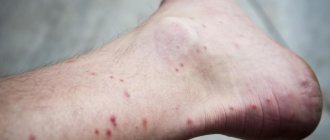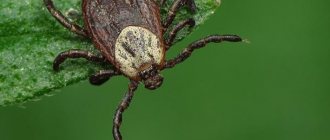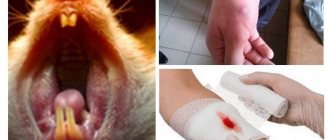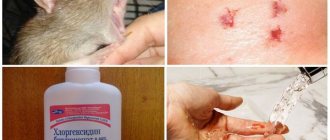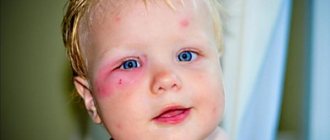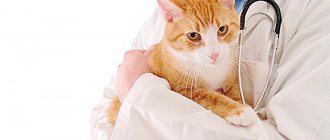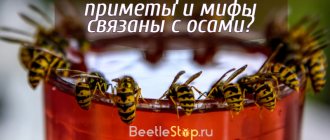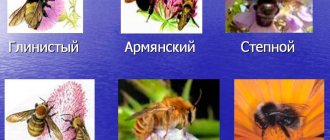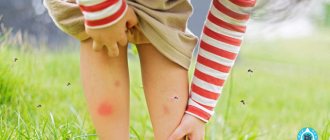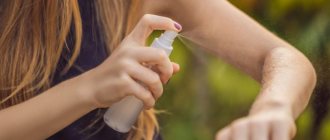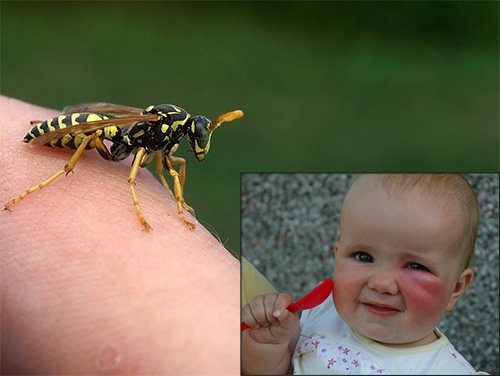
What to do if a child is bitten by a wasp? The first step is not to panic with your baby (as young mothers sometimes do) and stay calm. In the overwhelming majority of cases, the biggest troubles from a wasp bite in a child will be quite pronounced swelling and severe pain.
However, even these symptoms are sometimes enough for a whole day on vacation or in the country to be spoiled for both the child and the adults. In addition, the Internet, which young parents will turn to in the first place, is simply replete with various "horrifying" stories "from life", which also will not add peace of mind. Of course, the described severe consequences of wasp bites sometimes happen, but this happens so rarely that there is simply no point in accepting them as an obligatory outcome.
Adults know: if a wasp has bitten a child, severe pain will certainly appear, but after about a day it will almost completely disappear.
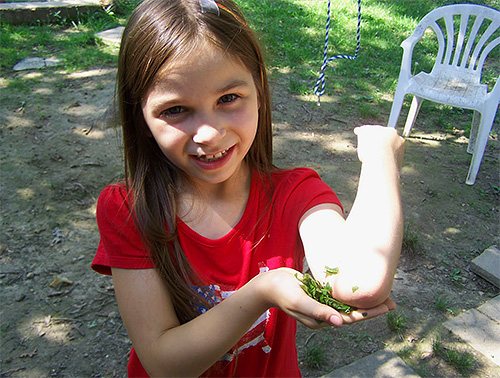

Next, we will look at what parents need to do in the first place, so that the consequences of a wasp sting in a baby go away as quickly and painlessly as possible. And also note what to do in those rare critical situations when the child's life can directly depend on the correct actions of the parents.
But first things first…
On a note
Wasps are different. The usual paper wasps, which are most often found, sting, quite painful, but they cannot be compared with long, very slender, brown or black road wasps - they are considered the owners of some of the most painful insect bites in the world in general. After an attack by these wasps, even an adult can experience a painful shock, and there is nothing to say about a child. However, fortunately, road wasps are much more rare than paper wasps, and only bite in exceptional cases.
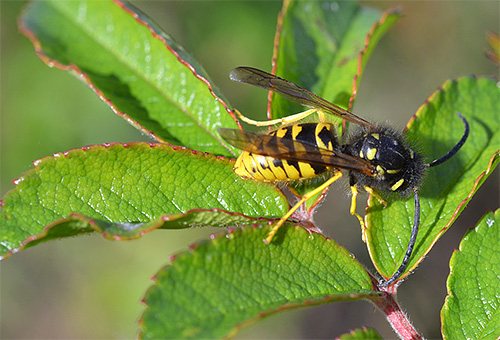

In fairness, it should be noted that some of the "horrors" on the topic of wasp bites still have a real basis. However, in the overwhelming majority of cases, all this does not happen to children: various complicated allergies, systemic reactions of the body and intoxication are more typical for adults.
The reason for this is rooted in immunology: sensitivity to allergens that make up wasp venom increases with each new bite... In this regard, the child's body is a "blank sheet of paper", which simply has not yet had time to accumulate the necessary "experience" for the development of a violent allergic reaction.
As a rule, hypersensitivity to any substance appears in an organism that has already encountered this allergen more than once. Simply put, for each subsequent sting, some people (and their minority) react more and more sharply.
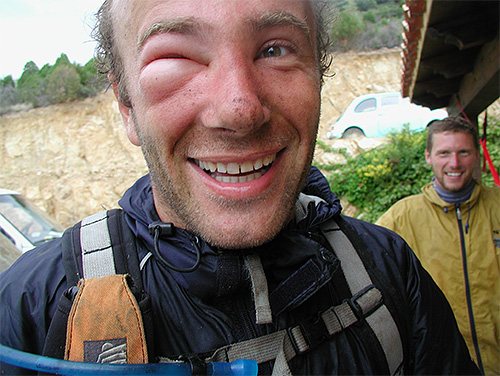

The average healthy adult person does not have such a response, since his body is capable of producing protective antibodies and quickly neutralizing the poison that has entered the bloodstream, and the baby's immune system is simply not yet familiar with it.
Thus, if a child is bitten by a wasp, then the consequences of this will in most cases be entirely due to the toxins of the poison, and not the development of an allergic reaction. Pain and inflammation, of course, will be - but without allergy symptoms (for example, hives and fever).
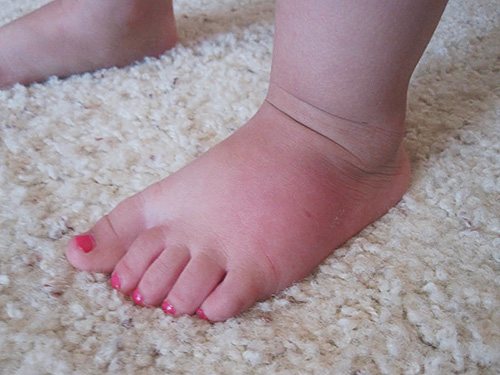

Only sometimes, in exceptional cases, a child may have a systemic reaction to a wasp sting. This is a topic for a separate conversation (we will consider it a little below), because such situations are already much more dangerous and require the use of potent drugs, and sometimes even hospitalization.
First aid for a wasp sting
If an attacking insect has been noticed and identified, then you can immediately proceed to first aid measures, otherwise the first step is to determine the type of offender. So, if we talk about wasps, the level of their aggressiveness is characterized by specialists as high. That is, if a bee sting is usually a manifestation of self-defense, then the wasps sometimes attack for no apparent reason. The main difference between these types of insects is the structure of the sting. Stinging, the bee leaves its sting in the victim's wound, as it has barbs and simply comes off, remaining in the skin. But the "tool" of the wasp, which under normal conditions for laying eggs, is smooth, so that with inaccurate actions, the attack can be repeated several times in a row. A dangerous toxin is released from the sting, which often causes a severe allergic reaction in a person.
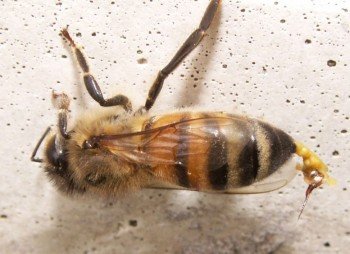

It is important to distinguish between a wasp and a bee - the difference in assistance is fundamental
So, you can recognize a wasp bite in a child by the following signs:
- severe, burning pain;
- a light, whitish environment is formed around the site of the bite, rising above the general level of the skin, and outside of it the focus of the inflammatory process spreads - the skin turns red;
- pulling pains in nearby lymph nodes may occur;
- severe swelling;
- a bite inside the mouth into the mucous membrane usually provokes severe swelling, which often leads to difficulty breathing.
In the event that you have established that the child was stung by a wasp, you should adhere to the following algorithm of actions:
- the poison that has got under the skin must be neutralized. This can be done with the help of acid, since the wasp poison is alkaline (lemon juice or vinegar is suitable);
- in order to minimize the risk of infection, the bite site must be disinfected using any available means (alcoholic tinctures, medical alcohol, hydrogen peroxide, etc.);
- the next step is to combat the symptoms. To reduce pain and delay the development of severe edema, a piece of ice wrapped in a small piece of tissue is applied to the bite site. You can use special balms after insect bites, which are sold in pharmacies, or resort to folk remedies - attach a piece of apple, tomato or cucumber, grease with dandelion or garlic juice.
Photo Gallery - Aid Tools
Probably the most important question - is it necessary to call an ambulance? In many situations, there is no such need, but it is necessary to seek help from specialists in such cases: there are many bites, lesions are localized in the neck, mouth and eyes, there is an allergy, breathing has become difficult, painful sensations and swelling persist for more than 3 days.
What to do if your child has allergies
Depending on the place of damage and the general condition of the body, a bite can provoke an allergic reaction of varying complexity and severity. The reaction of both the child and the adult develops very rapidly - on average, up to half an hour, it gains its maximum strength. Severe cases end for the child with Quincke's edema, which poses a direct threat to his life.
In the event that such a situation happened to an allergic child, parents must act extremely quickly. When this happens not for the first time, then it is worth using the drugs previously prescribed by the doctor. If the child's condition worsens, then you simply cannot do without medical assistance.In order to avoid unpleasant situations, it is better not to attract the attention of insects with a strong smelling perfume, sweets, and at home it is better to get nets on the windows.
Preparations for processing
There are three types of pharmaceuticals for treating the bite site:
- Ointments.
- Creams.
- Gels.
Ointments and creams are absorbed for a long time, so you need to wait a little after applying them. In addition, they are made on the basis of fat, so they almost always leave stains on clothes.
Gels are the most effective remedy, as they are quickly absorbed and easily washed off, because they do not contain oils, they are water-based.
The most common drugs are:
- Nezulin.
- Psylo balm.
- Bepanten.
- Fenistil-gel.
- Epidel.
- Soventol.
- Lifeguard, and others.
All these funds work according to the same principle, namely, they are absorbed into the affected areas of the body and neutralize the poison. Therefore, it is often written on them that they relieve itching and irritation, and this is indeed so, sometimes, thanks to the essential oils they contain. Some of these remedies specialize not only in insect bites, but also in other allergic reactions.
However, it is necessary to take into account contraindications for pregnant women and infants (if any), as well as in case of individual intolerance.
Do not panic!
What to do if a child is bitten by a wasp or bee? The main thing is that the adults who are nearby do not start to panic. Otherwise, they will only upset the baby even more. Most often, the most "terrible" troubles for your child will be swelling and pain, which will disappear soon. But this is also quite enough for all the people around the baby to spoil outdoor recreation.
The horror stories that are replete with the Internet talk about the horrific consequences of insect bites and, of course, they will not add peace. It should be noted: complex reactions in the form of severe allergic edema, respiratory arrest, of course, occur, but extremely rarely and almost always in adults. Therefore, it is not worth thinking that if a child was stung by a wasp, then there will definitely be a similar outcome. The body of babies cannot yet react in this way to insect bites.
If a child is bitten by a wasp, then it is the toxins that make up the poison that will cause swelling and discomfort, and not an allergy. There will be inflammation, pain, but the temperature will not rise, and allergic rashes will not appear.
By the way, there are two types of wasps. Paper wasps are the most common. They sting hurt, but bearable. But the road view of this insect bites so hard that an adult cannot restrain himself, crying in pain. They have a long body, brown or black in color. Painful shock with their bite is provided for both an adult and a child. But road wasps are much less common than paper wasps.
Helpful: At what age can a child sleep on a pillow?
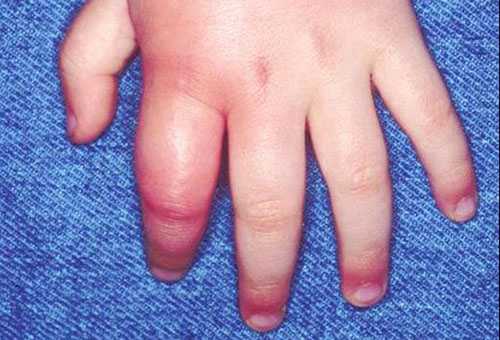

If a child is bitten by a wasp
Now, in fact, let's talk about what to do if a child is bitten by a wasp. We will also discuss some of the mistakes that overly caring parents make in such cases. So let's go.
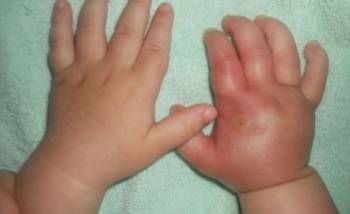

How does a child feel after receiving a painful sting from a striped insect? That's right, a painful injection! And if not kidding, then in general the sensations are the same as those of an adult. It is even worth saying that if this is your child's first bite, you don't have to worry. Most likely, in addition to pain, no side reactions should occur, this is much more typical for adults.
The fact is that wasp venom does not allow developing resistance with each new bite, on the contrary. It is the first wasp bite that can be considered the safest in relation to the occurrence of certain complications. But with each new sting, the risk of allergic reactions increases, especially with age.
But we got distracted.So, having received a sting prick, the child feels severe burning pain, as it should be in such cases. Further, swelling in the puncture site and an inflammatory process inevitably occur, as a result of the body's struggle (immunity) with the toxin that has entered the bloodstream.
What to do in this case?
Stay calm
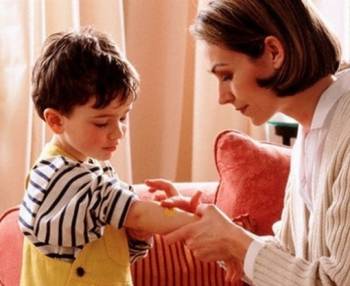

If your child is not allergic, there is not the slightest reason to panic. We know very well that all unpleasant pain symptoms will pass in a couple of days. Do not assume that the child's immunity will not be able to grind a portion of wasp poison as easily as the body of an adult healthy person does. As we said above, this happens even easier and more reliably in children.
Having shown calmness and confidence that nothing terrible has happened, we will only give confidence to our child in this. Having arranged a violent hysterics, on the contrary, you can add brushwood to the fire and only increase the already considerable stress that a little researcher inevitably experiences when he has learned such a painful lesson.
Examine the wound
So, having calmed the baby, you should get down to business. It is necessary to inspect the bite site for the absence of a sting there, because the crying child hardly understood who exactly bit him so painfully, a bee or a wasp.
Suck the poison from the wound
If everything happened in front of your eyes, you can and should even try to quickly suck out the poison that just got into the wound.
It should be remembered that it is the amount of toxin that has entered the body that is responsible for the severity of the course of recovery. If we manage to remove part of the poison in this way, there is no doubt that the recovery will take place very quickly and painlessly.
Disinfection of the bite site
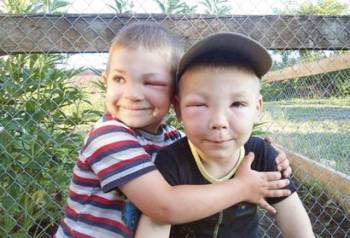

Next, we must disinfect the wound.
First, you can simply wash the bite site with soapy water, after which it will be correct to treat the wound with hydrogen peroxide or vinegar.
And it would be even wiser to attach a tampon with citric acid to the bite.
Wasp poison contains alkalis, and therefore citric acid can quite help, destroying this alkaline environment.
Removing inflammation
Now we turn to the localization of pain. This is almost the main point, considering that our patient is a crying child who needs to remove the pain.
To relieve swelling and pain, you can apply cold compresses to the injection site. A few ice cubes in cheesecloth work well. Cold generally tends to slow down the spread of the toxin, in addition to dulling the reaction of nerve endings to an irritant.
You can also apply compresses using a baking soda solution, which will also help reduce itching and reduce swelling and inflammation at the site of the sting.
Drinking a lot
A very important point, by the way. In order to increase the metabolic rate in the victim's body, it is necessary to give a lot of warm sweet drink to a child bitten by a wasp.
The liquid allows you to speed up the process of removing toxins from the body. Tea, warm water with lemon juice and sugar are great. In this case, you should not give milk to a young patient.
Medications
Further, just in case, you can give the affected child an antihistamine, such as suprastin or diazolin. Especially if we have some suspicions about the possibility of an allergic reaction.
Stinging insect bites
Stinging insects such as a bumblebee, bee or wasp, when attacked, release a poison that is usually not safe for children. However, if the baby has an allergy, then the bite of a wasp poses a serious danger to his health and even life.
Hypersensitivity reactions most often occur immediately after a bee attack. With multiple bites, allergies are very pronounced.
The site of the bite swells, dizziness occurs, fever, vomiting and swelling of the larynx begins. The latter is especially dangerous, as suffocation is possible.
Experts identify the following characteristic signs that develop after stings of a bee, bumblebee, wasp and other stinging insects:
- sharp painful sensations;
- the bitten place begins to swell, which is extremely dangerous, especially if a bee, wasp, bumblebee stuck a sting into the head and neck of the child;
- redness of the skin;
- headaches;
- vomiting;
- heat;
- chest pains.
The sting of a bee resembles a serrated spear, which is why these insects can only sting once. But the wasp and bumblebee are capable of attacking as many times as they like. However, bees, bumblebees, and other stinging insects attack only when they sense danger.
First aid for a sting of a wasp, bee, bumblebee
We have figured out the identification of some of the stinging insects. We also found out what are the symptoms of their bites. Now it remains to find out what to do if you have been stung by a wasp, bee, bumblebee or their relatives.
Get rid of the sting
It must be remembered that when a wasp is bitten, you do not need to look for its sting on the body, because she does not leave him, well, of course, unless you "sealed" her to yourself. It is quite another matter with a bee sting. The bee has a jagged sting, so it must be removed. This is a simple matter, the main thing is to disinfect the wound, as well as the bee sting extraction tool, so as not to infect the wound. This can be done using: peroxide, ammonia diluted with water, iodine, alcohol solution, corticosteroid ointment - for a wound, ordinary rubbing alcohol - for a tool, such as tweezers.
Important! It is not worth squeezing out the poison, as you can easily infect
Stop the spread of poison
Now that there is no sting, it is necessary to prevent the spread of poison in the body, as well as prevent an allergic reaction.
- With a general toxic reaction, the victim is advised to drink as much as possible. Preference - sweet water, hot sweet tea;
- In place of the edema, put a heating pad with cold water or a wet towel, which will slow down the absorption of the poison;
- Soak a cloth with a baking soda solution (1 teaspoon for 1 glass of water) and leave it on the sore spot for 15–20 minutes.
- A piece of moistened sugar attached to the wound helps to draw out the poison.
- An allergic reaction is prevented by taking antihistamines such as Claritin, Suprastin or other similar drugs.
Eliminate pain and swelling
The following remedies can be used to relieve pain and swelling:
- Apply a cold compress or ice wrapped in a cloth to the bite site for at least 30 minutes. You can also apply a compress from a cloth dipped in alcohol or vinegar and water;
- Make a lemon juice compress. Eliminates pain and swelling;
- You can make a compress from tincture of a golden mustache with vodka;
- Attach a cut onion, tomato or garlic to the bite;
- Attach a cut apple to the wound;
- Apply pounded or chewed fresh parsley leaves to the sore spot;
- Anoint the wound with Psilo-balm or Fenistil gel;
- Apply Validol tablet moistened with water to the bite site;
- Take diphenhydramine. It is necessary to take this remedy if the swelling is too large, i.e. if there is an allergic reaction;
- Soda gruel with water. Attach to the bite site. Relieves redness, and swelling, and pain;
- Attach a Kalanchoe or plantain leaf to the wound;
- Lubricate the skin at the site of the bite with a solution of calendula or plantain. They can be purchased at the pharmacy;
Important! Alcohol is contraindicated because it leads to increased edema
To prevent a sharp drop in blood pressure caused by hives, the victim can be given 20-25 drops of cordiamine.
Important! People who are allergic to insect bites during the summer are advised to always have with them the so-called passport of an allergic patient issued by an allergist.The passport contains the name of the owner, his age, home address, phone number, diagnosis, the phone number of the allergy room where the patient is observed, and the urgent measures that must be taken in case of a Hymenoptera bite
In addition to the passport, it is advisable to have a syringe and a set of medicines listed in the passport with you. In the event of anaphylactic shock, you must immediately call an ambulance or deliver the victim to a medical facility.
general information
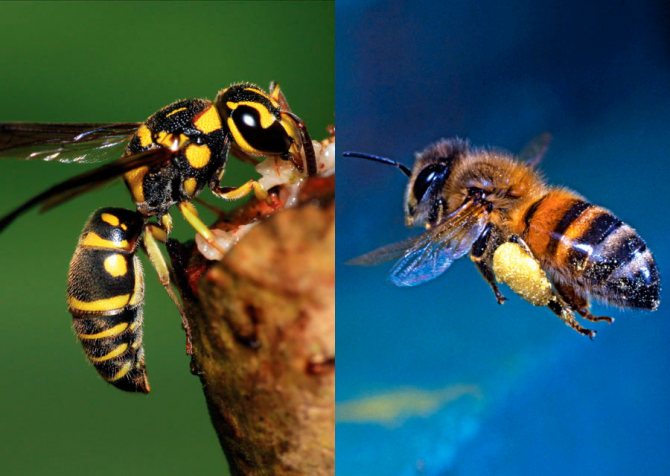

Bees are representatives of the order Hymenoptera, and wasps belong to the suborder of stinging stalk-bellied insects.
Bees:
- Scientists are aware of more than 520 species of bees.
- Bees are found on all continents except Antarctica.
- She has a proboscis, with the help of which the bee collects pollen, and also drinks sweet nectar.
- The bee has two pairs of wings, while the rear pair is somewhat shorter.
- The sizes of these insects range from 2.1 mm to 39 mm.
- With the help of antennae, in the form of antennas, the insect orients itself in space.
- Bees live in a swarm, inside which there is a queen. Bees always guard her. In addition, there are drones and worker bees in the family.
- Adult bees can live both separately and in families where there is a division of labor.
- Worker bees are busy collecting honey all the time, and they build honeycombs for storage from special substances that they themselves emit.
- In apiaries, bees live in families in hives. One hive can contain up to 40 thousand bees.
There are several main types of bees, such as:
- Honey bees.
- Chinese wax bees.
- Alfalfa leaf cutter bee and others.
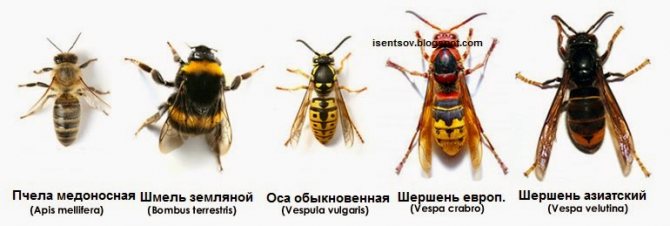

What you need to know about bees:
- Bees pollinate many plant species that are highly dependent on this process. Bees are extremely useful creatures and represent the largest group of pollinators in the global ecosystem. Farmers often use the services of beekeepers, agreeing on the placement of apiaries in the vicinity of farmland.
- These tiny creatures play an important role in the balance of nature, which many people do not even suspect. People are so used to this neighborhood that it seems that nothing threatens the bees at all. In fact, this is not the case and bees are constantly exposed to negative influences: they die from poor ecology, from killer bees, from poisons in the fields and in gardens, which leads to a decrease in numbers around the world.
- If the bees disappear, then humanity is unlikely to survive, since without them it will not be possible to grow most of the harvest. Only insects can cope with such a large-scale task as transferring pollen from male flowers to female flowers. It will be difficult for a person to cope with such a problem, and some farmers from the USA, China and other countries of the world were convinced of this when many bees died. We had to hire special workers to pollinate the plants.
- Nowadays, bees experience many factors that influence the behavior of bees. These are viruses, mobile signals, and chemistry. As a result of this action, bees have difficulty finding their way to their home. When new swarms are formed, they do not want to fill the vacated hives. Beekeepers have been demonstrating to urge the government to take steps to conserve these beneficial insects.
First aid for a bee or wasp sting - what should a child urgently do after being bitten by insects?
Situation
How to provide first aid?
A child was bitten by a wasp / bee in the finger There is a fundamental difference in the sting of a bee and a wasp
A bee leaves a sting in the body, because its sting is serrated, and in a wasp the sting is smooth, it does not leave it in the body. If a bee stung, then first you need to disinfect the sting site with hydrogen peroxide, alcohol or a weak solution of potassium permanganate, then very carefully pull out the sting with tweezers or a needle so as not to crush the ampoule with poison located at the end of the sting. Then attach a swab dipped in a soda solution, because
The pH of bee venom is acidic and is neutralized by an alkaline solution. If a wasp stung, do everything, the same, just don't poke around in your finger trying to find the sting. He's just not there. After disinfecting the bite site, attach a tampon soaked in table vinegar with 3% vinegar, because The pH of the wasp venom is alkaline. Keep the tampon in both cases for 15 minutes.
A child was bitten by a wasp / bee in the hand In the case of a bite in the hand, all first aid procedures are performed in the same order as in a finger bite. A child was bitten by a wasp / bee in the face If a wasp / bee stung a child in the face, then in this case, the first aid will be similar to the two previous ones. Disinfect and remove the sting. Then attach a tampon dipped in a soda solution or a solution of potassium permanganate. Do not forget that a bite in the face can cause complications, because the skin in this part of the body is tender and the poison penetrates into small blood vessels faster. It is advisable to apply ice to avoid or delay the spread of the poison. If there are no hospitals nearby and medical care is not available, use proven folk recipes: treat the wound with garlic or plantain juice and attach a cut tomato, cucumber, onion or apple. Finely chopped parsley root helps a lot, it's good if thrifty housewives have a tincture of propolis or calendula. A child was bitten by a wasp / bee in the leg With a bite in the leg, the first aid scheme does not fundamentally change. The child was bitten by a wasp / bee in the lip In this case, it is necessary to stop the spread of swelling and inflammation as soon as possible. We quickly remove the sting, if there is one, apply ice or a handkerchief dipped in water. It is advisable to have ascorbic acid, loratidin or suprastin with you, if they are not available, you can give the victim a lot to drink non-hot sweet black tea. Already sounded folk methods will help here, but it is better not to postpone a visit to the doctor. The child was bitten by a wasp / bee in the neck Since the bite site is located near the lymph nodes, first of all, you will have to take care of the non-proliferation of poison. All of the above actions will help neutralize the threat of edema. Give plenty of fluids to drink, preferably in small doses at short intervals. Pharmacological balms will protect the baby's skin from damage, antihistamine ointments will reduce irritation and increase the body's resistance. Child bitten by a wasp / bee in the eye The most severe case. Try to see a doctor as soon as possible, if possible, give antiallergic drugs in an acceptable dosage Explain to the child that crying in this case is very harmful, but do not frighten, but distract his attention from the pain.
After having provided first aid and consulted a specialist, you need to take care of proper care and supervision of the baby.
What nuances need to be taken into account - we will find out right now.
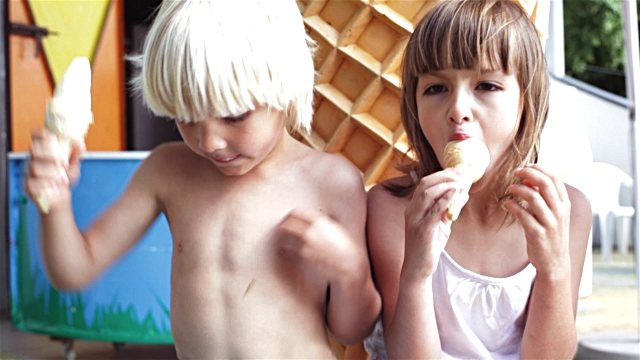

What cannot be done?
When bitten by a bee or bumblebee, it is important to know not only the steps to take, but also what not to do. First of all, there is no time to waste organizing the search for the attacking insect. If the baby was attacked by a wasp, then it can repeat its attack, so it is better to leave it alone and not provoke it.
The bee dies after the attack, leaving a sting in the human body. The sting contains a large amount of poison, so rubbing the bite should not be allowed. When a child presses on a wound, toxins quickly enter the bloodstream and spread throughout the body.
Wasp sting: what can you do at home?
The peculiarity of our population lies in the fact that we love to treat everything with the help of alcoholic infusions and remedies. In this case, it is strictly forbidden to use such methods, as this can provoke an even more active development of edema and lead to serious consequences. However, traditional medicine has many recipes for eliminating the effects of bee and wasp stings:
• Recipe 1: for a wasp sting, apply a compress with lemon juice, and for a bee sting, wash with liquid soap
• Recipe 2: it is recommended to lubricate the affected area with the juice of chopped parsley
• Recipe 3: it is believed that tea lotions, aloe juice, onion or plantain juice will help relieve swelling
• Recipe 4: to relieve swelling, it is also advised to apply cold to the bite site, a compress from calendula tincture or a sugar cube
Bee or wasp sting - folk recipes for disinfection
Summer time of the year, hot weather is always good. Many people take a vacation for this period, and schoolchildren go on vacation. Everyone "relaxes" near water bodies or in the country. Unfortunately, summer is not complete without arthropods, which can poison our rest, and some of them are dangerous.
It is believed that within our climatic zone, the bulk of arthropods are not capable of causing great damage. But, there is always an option to become infected with all kinds of ailments through an insect, but some of them may turn out to be dangerous, and their poison - toxic. It is worth considering several folk recipes that can protect us from such already known arthropods as the wasp and the bee.
1. Garlic helps with bites very well. It can be divided and pressed against the base of the bite, such a manipulation will relieve swelling and pain. It will be more effective to press the garlic into the gauze, roll it up and apply it to the bites.
2. Nobody canceled Urina yet. Your own urine will also remove winged arthropod bite marks. It is enough to "go" on a rag and apply it to the wound
But, be careful: there is a danger of infection in the wound!
3. If you have removed the sting from the wound long ago, and the pain does not subside, a dandelion will come to the rescue. Dandelion juice must be squeezed onto the wound. Dandelion juice will act as a sedative, after a few minutes the pain will disappear. In order for the wound to heal faster, the procedure should be repeated several times a day.
4. Marigold flowers can also help. Calendula flower juice can be combined with plantain sprouts.
5. If you have been bitten by more than one bee, but by several, take a bath with an elixir made from elderberry roots and tops. Before this, the berries must be steamed with hot water and allowed to stand for several hours. Do this as quickly as possible.
6. There is one more "old-fashioned" method of eliminating the consequences of bites. The sting needs to be removed, and a cold knife or, say, a metal spoon should be applied to the affected area. They must be sterile. You can pre-alcohol them.
Why are children at risk?
Indeed, most often we get a very painful sting prick for the first time when we are children. And this is not surprising.
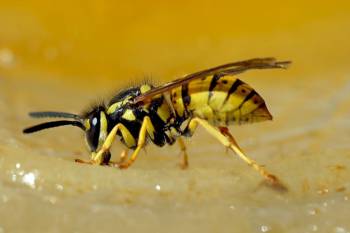

It is almost impossible to observe prevention here, because children tend to spend a lot of time in the fresh air, swarming in the grass, in search of a grasshopper or other insects. Children often climb trees, more often they go to the forest both with adults and themselves.
Thus, our children "on duty" have much more often than an adult who is accustomed to the "home-work-home" regime to find themselves in the habitat of insects, among which there are many biting striped aggressors that can teach the hapless kid to be careful. It is precisely the quality that in many ways distinguishes a child from an adult.
In short, a child tends to analyze much less the possibility of the consequences of an action. But what can I say, even in adolescence we tend not to believe in the possibility of serious blows and defeats, we live according to the principle "we have a sea up to our knees." What can we say about a 5-10-year-old kid who is firmly convinced that the whole world is at his feet and this world will never hurt him.
Alas, sooner or later these hopes will be dispelled.And quite often this happens just after a wasp or other insect bite, which is very painful for a child.
Precautions - how to protect yourself from bee and wasp stings
Winged arthropods are "greedy", in addition to fruits and sweets, also on human costumes. Bees love bright colors in outfits, as well as patterns of flowers. Wasps prefer rotten fruits, sugary foods and drinks.
During the period of activation of these insects, it is important not to allow food to spoil in your home, or near it. See if your loved ones close the bin after throwing the trash into it.
If you see that bees or wasps have appeared where there is a congestion of people, ask them to not move so sharply. People who move slowly are usually out of sight of insects.
In summer, you want to enjoy all the delights of hot weather. If you are afraid of attacks by bees or wasps, do not walk barefoot or in open shoes on the grass, go around flowering bushes.
If you are presented with a bouquet, make sure there is no bee in it before you start smelling it. It may look very interesting, but sometimes it saves you from negative consequences. This is especially true for those who suffer from violent allergy to bites.
Insects will pay less attention to you if you smell natural and clean at the same time. Sweat and floral scents can rebel in bees and wasps alike
Air the living area only after sunset. Towards evening, all the bees return to their nests and will no longer bring you damage until the very morning.
Such simple rules will help not only adults, but also small children survive the summer heat. No need to kill insects.
Insects are never the first to touch humans, in 99.9% of known cases. Most often, their sharp reaction is provoked by an extraneous smell or color of clothing.
Bees and wasps are ready to pollinate anything that looks beautiful and smells attractive to them. It is in their nature, and we cannot change their foundations. Be vigilant and careful.
Midge and mosquito bites
Mosquitoes and midges are the most common insects in central Russia that suck human blood. In the summertime, they bring a lot of inconvenience to children and adults.
The common feature of these "enemies of man" is the following: before starting the "meal", they try to inject saliva into the skin through the proboscis, which contains anticoagulants - compounds that prevent blood coagulation.
It is with saliva that mosquitoes can transmit to people a variety of dangerous diseases, including malaria, dirofilariasis (parasitic disease), tularemia, encephalitis and meningitis.
However, in our country, a mosquito bite rarely becomes the cause of any ailment, much more often the place of a mosquito "attack" itches so badly that a child is able to infect.
Signs of an insect bite are a small reddened area of the skin, slight swelling and severe itching. Usually, after a couple of days, such symptoms disappear, and the skin regains its previous appearance.
An allergy to a mosquito bite and other blood-sucking insects develops rarely and is not as strong as to a prick of stinging insects - bees and wasps. Signs of an emerging allergy in children are as follows:
- swelling of the skin at the site of the bite;
- high temperature;
- headaches;
- severe itching;
- vomiting.
Very rarely, hypersensitivity to the bites of blood-sucking insects can lead to types of allergies such as hives, bronchospasm or anaphylactic shock.
If the child is bitten by a midge, then the sensations are much more painful. The fact is that, unlike mosquitoes, which pierce the upper layer of skin with their proboscis, small gnats bite out part of the skin. As a result, the bite site swells and swells much more.
Helping a child
If bitten by a wasp, it is important to provide first aid as soon as possible. To do this, follow these steps:
- rinse the wound under cold running water to get rid of the remains of poison and particles of dirt;
- disinfect it with any ammonia, medical alcohol, brilliant green, iodine, or hydrogen peroxide to prevent a secondary infection;
- to neutralize the poison that remains in the wound and gradually enters the bloodstream, apply a cotton pad dipped in a solution of vinegar to the damaged area (stir 1 teaspoon of the product in 100 ml of water), furacilin or streptocide (1 tablet per 200 ml of water);
- to slow down the spread of poison, apply a cold compress or ice cube for 15 minutes;
- to reduce the risk of developing an allergic reaction, give your child an antihistamine (Suprastin, Zodak, Zyrtec, Fenistil, Claritin).
Folk remedies
Since wasp bites are very painful, especially for babies, the main task at home is to relieve these sensations. For this, proven folk remedies are used that are completely harmless to children.
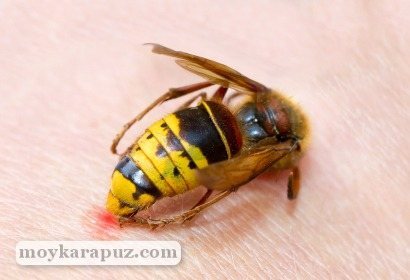

As a rule, all pain and swelling disappear without a trace within a week. To speed up the processes, folk methods will help:
- make a pasty mixture of soda, water, apply to the wound, let dry;
- prepare a foam of laundry soap and lubricate the bite site;
- lubricate the wound with dandelion juice, celandine, aloe;
- Apply menthol toothpaste to the bite for 5 minutes;
- prepare a mass of grated onions and apply to the sore spot.
Also, in the fight against edema after wasp bites, the juice of potatoes, carrots, beets, lemon or grapefruit will help.
Pharmacy preparations
It is advisable to treat a wasp sting in a child with a pronounced reaction (severe redness, swelling, itching) with drugs that have anti-inflammatory, decongestant, antipruritic and healing effects. The following remedies are effective: Fenistil gel, Zvezdochka balm, Psilo-balm, rescuer ointment, Bepanten.
In the case of a secondary infection, it is necessary to treat the bite site with Vishnevsky ointment, Solcoseryl, Levomekol.
To prevent the development of an allergic reaction, the child needs to drink a pill or drops of an antihistamine (Suprastin, Zodak, Zirtek, Fenistil, Claritin).
Help depending on the bite site
In this case, the treatment can be somewhat differentiated:
- Stung in the finger, arm or leg. It is necessary to rinse the wound with cool water, treat it with disinfectants, neutralize the poison with any acid and apply a cold compress. In case of redness, swelling, treat the bite site for a week with any decongestant and give an antihistamine. The spread of the toxic substance throughout the child's body will help prevent the application of a bandage above the bite site. After processing and neutralizing the poison, the tourniquet is removed.
- What to do with a bite in the eye. In this case, you need to seek help from medical professionals, because this area is a very vulnerable place. In the absence of such an opportunity (for example, a wasp stung a child on a vacation in nature), you need to help yourself. Do not try to suck out the poison, it can only introduce an infection. Treat the bite with hydrogen peroxide, apply a cold compress (cloth soaked in cold water) for 15-20 minutes and give an antihistamine. A wet lump of sugar, lemon will help to draw out the poison. The child needs to drink plenty of water - sweet water or hot tea.
- If a wasp has bitten on the neck. In this situation, the risk of laryngeal edema increases. You need to give the child an antihistamine and call an ambulance.
- With bites in the ear, the forehead is usually a minor reaction, since the likelihood of wasp venom getting into the blood is reduced. It is necessary to treat the wound with an antiseptic and apply cold.
- Lip bites are not dangerous, but they usually cause severe swelling that makes it difficult for the baby to open his mouth. Apply a cold compress or ice cube to quickly relieve puffiness.
Wasps, bees, bumblebees, hornets
A bee or a wasp, when bitten, releases poison, which in itself is not dangerous for a child who does not suffer from allergies. However, allergies are not uncommon. Especially dangerous are cases when a wasp or bee stings in the head, neck or lip. The poison with such a bite goes directly into the bloodstream.
An allergic reaction after a wasp or bee sting manifests itself almost immediately. If there were several bites, the allergic reaction may be more pronounced. Causes severe swelling at the site of the bite, dizziness, fever, vomiting and laryngeal edema may appear. This is a very dangerous condition.
Some people develop allergies after a while. Therefore, it is necessary to carefully monitor the condition of the child for several days and note any unusual changes.
There are several specific signs characteristic of a wasp, bee, bumblebee or hornet sting:
- pain, burning at the site of the bite;
- the site of the bite and surrounding tissues swell. This is a very dangerous sign, especially if the insect stung the child in the neck or head;
- bright rashes at the site of the bite;
- dizziness, headache;
- nausea or vomiting (a sign of severe intoxication);
- chills;
- body temperature rises;
- painful sensations in the chest.
The most important thing when a child is bitten by a wasp or bee is not to panic, but to take prompt action:
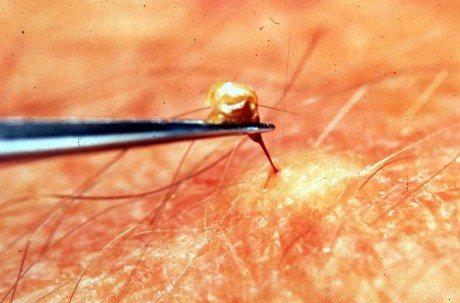

after a bee sting, a sting remains, which must be carefully removed with tweezers, or scraped off with a hard object. You cannot pull out the sting with your fingers - the squeezed out poison will only intensify the reaction
Wasps and bumblebees do not leave a sting, but their bite is dangerous with infection, so the wound should be treated as soon as possible; first, the bite site is washed with soap and water, then treated with an antiseptic. This will prevent infection; you can neutralize the poison as follows: rub lemon juice or powder of a crushed aspirin tablet into the bite; do not allow the child to comb the bite site; a compress with an aqueous solution of ammonia (ratio 1 to 5) or a weak solution of potassium permanganate will help reduce pain. You can also treat the bite site with menthol ointment or lidocaine; after a while, the bite site will begin to swell. A cold compress (a cold object or ice wrapped in a cloth, cold water in a bag) will help reduce puffiness; give the child an anti-allergenic drug. You must follow the attached instructions and observe the dosage. You can use fenistil ointment; in no case should you apply earth to the bite site, as folk remedies advise. This will not relieve pain and swelling in any way, but it is very easy to infect in this way; fresh potatoes or a slice of tomato will help reduce itching; dissolve 1 tablet of validol in 0.5 glass of water and make lotions. After 20 minutes, the swelling will subside (it also helps with midge bites); the bite site can be treated with onion juice, which has an anti-inflammatory effect.
From plants when bitten by a wasp or bumblebee, you can also pay attention to plantain, rhubarb and parsley root, which also have antimicrobial and anti-inflammatory effects. From ready-made products, psilo balm and irikar are effective
They quickly relieve itching and burning.
When to see a doctor
The swelling and itching after an insect bite should go away in a couple of days. If after this time they have not passed, it is necessary to consult a doctor to rule out allergies or infection.
For a number of symptoms, you need to call an ambulance as soon as possible, since their presence may indicate a serious complication:
- wheezing. May mean incipient suffocation. This symptom is very common when bitten by a wasp or hornet;
- numerous bites;
- chest pain. This may be a reaction of the heart to a large dose of poison that has entered the body;
- labored breathing. The child speaks with shortness of breath, his breathing is intermittent and confused.Such a sign may indicate swelling of the larynx or pulmonary edema;
- difficulty swallowing or pronouncing words. It can be asphyxiation or a disorder of the nervous system that blocks important reflexes;
- a long time passed after the bite, but the wound began to fester. Possible infection of the bite site;
- shortness of breath, dizziness. Sign of intoxication, laryngeal swelling, or pulmonary spasm.
If a wasp or bee has bitten a child under three months old, you need to see a doctor immediately!
Mosquitoes, midges
Mosquitoes are the most common blood-sucking insects. In the summer, everyone suffers from them: both adults and children. In addition to the fact that the mosquito bite is unbearably itchy, these insects are still dangerous carriers of infection.
A typical reaction to a mosquito bite is as follows: the bite site becomes red, slightly swollen, and itches a lot. After 2-3 days, the listed signs disappear. In some cases, a serious allergy may develop: after the sting, a large painful swelling is formed that resembles a bee sting, the color of the swelling varies from light pink to bright red.
This is what mosquito bites look like:
This is what an allergy looks like after a mosquito bite:
The swelling can reach ten centimeters in diameter. In rare cases, there is a general reaction of the body to a substance that has entered the bloodstream during a bite: a rash all over the body, severe itching, Quincke's edema. The development of anaphylactic shock is indicated by such signs as shortness of breath, decreased pressure, tachycardia and vomiting.
First aid for a child with a mosquito bite
- the bite site must be disinfected with brilliant green. This will prevent infection of the wound;
- a cool compress should be applied to the bite site. This will relieve itching;
- a solution / gruel of soda (a teaspoon of soda and a tablespoon of water) helps from itching. You need to lubricate the bites every 40 minutes;
- if there are several bites, it is better to give the child an antihistamine or apply an anti-allergenic ointment (for example, Fenistil);
- rubbing the bite with tomato juice will help from itching;
- kefir or sour cream can be used as an emollient;
- raw potatoes will relieve fever and reduce the inflammatory response at the site of the bite;
- one of the folk remedies for forgiving swelling and inflammation is the application of a plantain leaf;
- toothpaste relieves itching and burning;
- balm "Zvezdochka".
Anti-bite ointments (after mosquito bites): Boro-plus, Fenistil, La-cree, Fladex, Lifeguard, Detox balm, Baby Gardex balm-stick, OZZ balm - consult a pediatrician before use.
Mosquito repellent: MOLOCHKO-SPRAY MOSKITOL, Mosquitall Set Mosquito, Milk / Cream / Spray Mosquitall, Organic Mosquito Repellent Oil for Children Mommy Care, ZANZHELAN SPRAY, Gardex Baby Milk to protect children from mosquitoes with sun protection. Gardex Baby spray, Johnsons Baby anti-mosquito lotion. Protection: mosquito nets, fumigators (devices that vaporize substances poisonous for mosquitoes (fumigants)), ultrasonic mosquito repellents (emit radio waves of a certain frequency, repelling insects. Attaches to a crib or stroller, runs on batteries), Mosquito wipes and bracelets.
The midge bite is more insidious, as it is not immediately felt. Redness and itching appear only after a while. A midge bite is more unpleasant than a mosquito bite.
The child was bitten in the ear by a midge (the ear was very swollen):
Very often, midges bite in the eye and the eye swells completely.
How to help a child with a midge bite
- Apply a cool compress to the bite to stop itching and swelling;
- care must be taken that the child does not scratch the bite site, as an infection can be introduced into the bloodstream.
In general, the same techniques are used as for mosquito bites.
First aid for a wasp sting
When you have been bitten by a wasp, the first step is to leave the space where these stinging insects live. One bite is not as dangerous as several.
If you notice a wasp on yourself or another person, in no case try to swat it:
- A sting of a killed insect may remain in the thickness of the skin.
- The wasp's ventricle contains a special signal enzyme for congeners. It stands out when the insect is crushed - the rest of the wasps rush to attack the offender.
Once in a safe place, you need to provide the victims with first aid:
- Make sure there is no sting in the wound. It is not forgotten by wasps, but by bees - these "minke whales" are very easy to confuse.
- Try to suck the poison out of the wound - they do not swallow saliva, but spit it out. In about a minute, you can draw out all the poison that the insect exuded.
- Offer the victim a generous drink. Best of all is sweet warm water or sweetened tea.
- To slow the spread of the poison, a cold compress is applied to the wound. An alternative is to dilute a soda solution (1 teaspoon for 1 glass of water), soak a cotton swab in it, apply it to the affected area for 15-20 minutes. From folk remedies - lean a piece of sugar against the swollen area.
- To neutralize the effect of wasp poison - apply an acidic slice of citrus to the wound. Another option is cotton wool dipped in vinegar.
- Disinfect the bite site with an antiseptic preparation - ethyl alcohol, medical iodine, hydrogen peroxide, "brilliant green", furacilin solution. If there is nothing at hand, rinse the wound under running clean water.
- Apply a cold lotion to the already disinfected skin - so that the bite site does not swell too much.
- For preventive purposes, offer the victim an antihistamine - against an allergic reaction.
With first aid, the main thing is not to make a mistake, so as not to worsen the victim's condition. Doctors advise the following:
- Don't look for a sting - wasps, if you don't press them, they won't leave it. The first step is to suck out the poison so that the tumor does not become large and painful.
- Do not rub the wound in an effort to squeeze the poison out of it with your fingers. Such manipulations stimulate the flow of blood to the site of the bite. On the contrary, it will make the allergic reaction more pronounced.
- Do not cauterize the stung area. The assumption that under the influence of high temperatures the poison is neutralized is erroneous. Much more likely to get a burn and an ugly scar for life.
- "Traditional" methods of disinfecting the wound with earth, clay are not suitable - this can provoke suppuration. It is necessary to use only medical antiseptics, and in their absence, clean water.
- You should not drink alcohol with a pronounced allergic reaction - alcohol stimulates blood flow, which, in turn, leads to the spread of poison throughout the body. In order to quickly remove the toxic substance, it is recommended to drink more water.
- It is a big mistake to treat the bite site with fresh urine from an adult or child. It cannot be called sterile, even if the "supplier" is absolutely healthy.
When assistance is provided on time, the victim does not suffer from allergies, the unpleasant symptoms subside after a few hours. If the striped one is bitten in the face, head, the swelling can last a couple of days.


